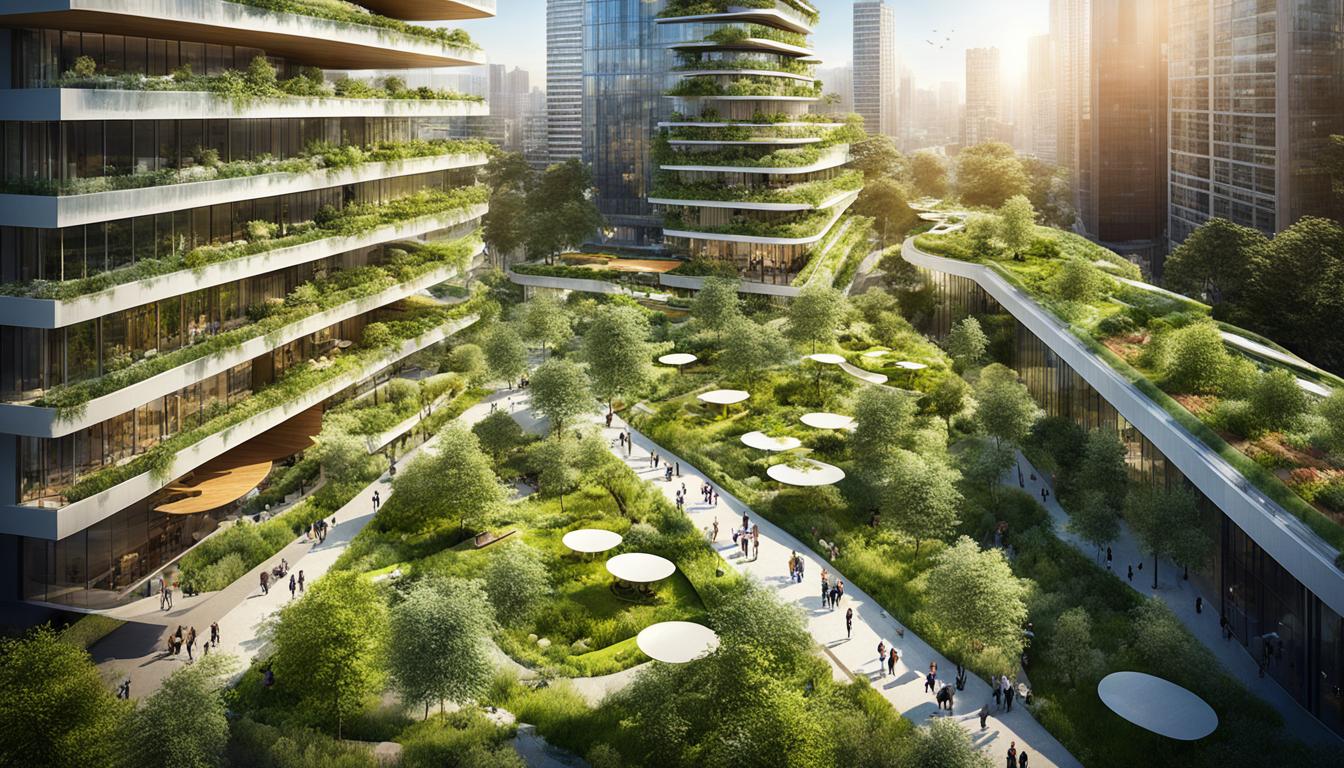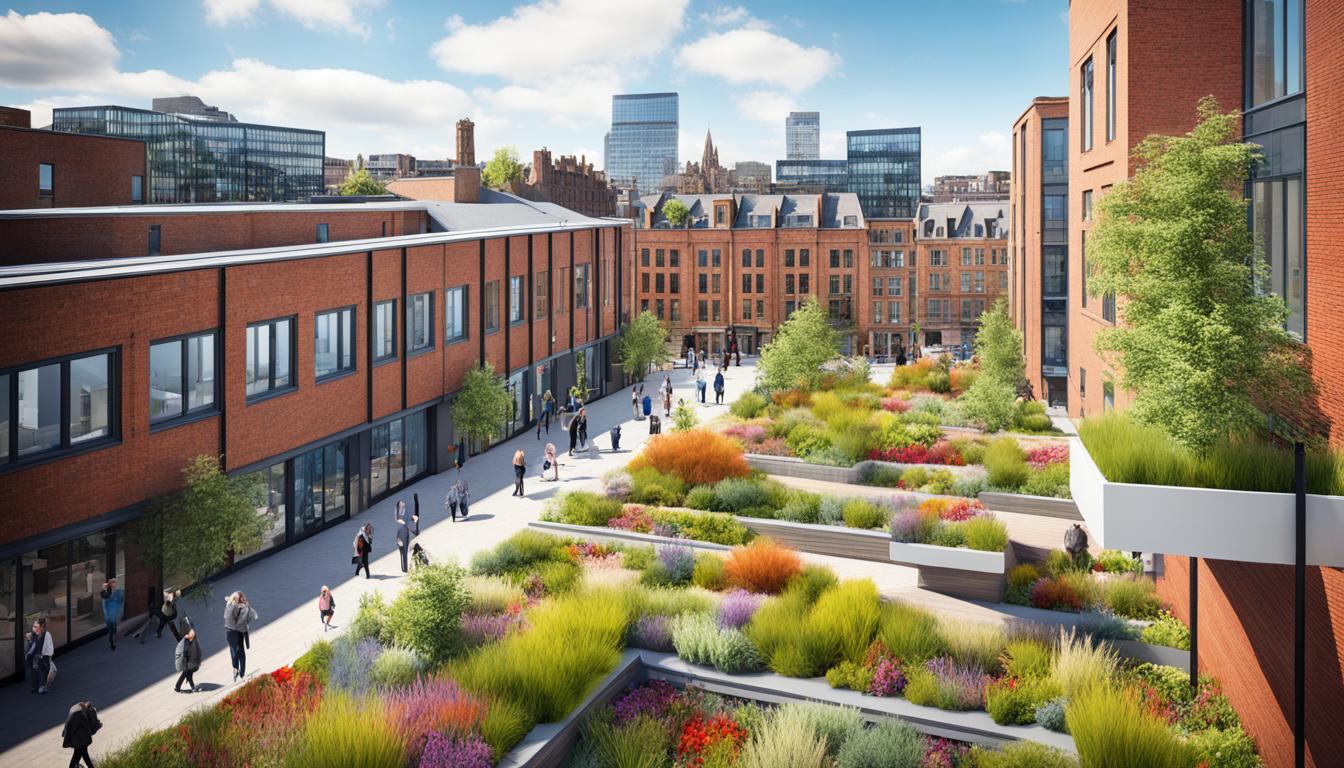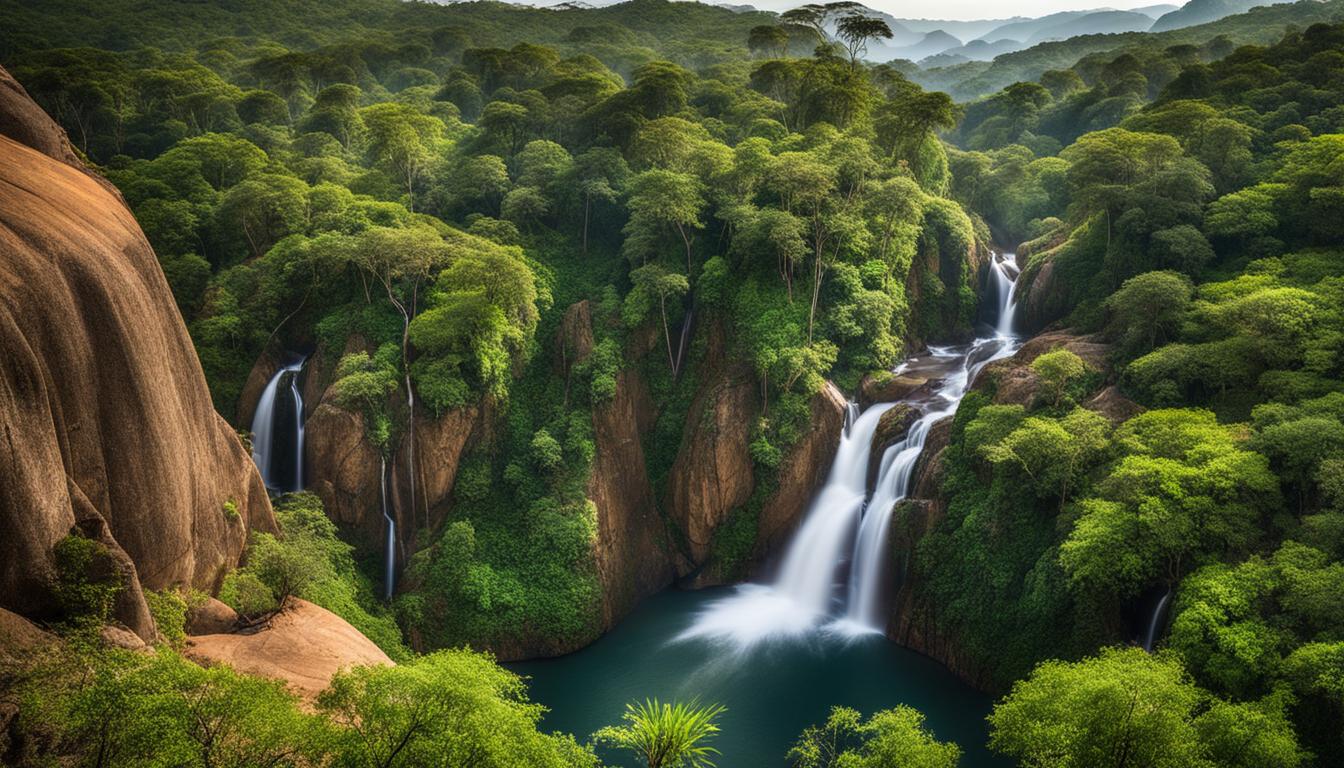Architectural Strategies for Enhancing Urban Biodiversity
Did you know urban areas now cover about 3% of the Earth’s surface? They also hold over 50% of the global population. But this growth is a big challenge for the nature living in our cities. That’s where architectural strategies for enhancing urban biodiversity come in. They provide key solutions for better biodiversity connectivity.
With cities getting bigger fast, urban ecosystems are in danger. This rapid growth harms natural habitat and causes fragmentation of existing habitats. This leads to isolated animal groups, less diverse genes, and more human-wildlife conflicts. That’s why architects and planners must act. They need to design in ways that support nature. This includes green infrastructure, ecological corridors, and habitat conservation.
Many opportunities exist for architecture to enhance urban biodiversity. Through biophilic architecture, designs can include nature. Biodiversity-friendly landscaping and urban rewilding are also great methods. These approaches allow us to make cities places where both people and animals thrive.
Key Takeaways
- Rapid urbanisation poses a significant threat to urban biodiversity, with the loss of natural habitats and fragmentation of existing habitats leading to isolated populations and reduced genetic diversity.
- Architectural strategies for enhancing urban biodiversity, such as biophilic design, biodiversity-friendly landscaping, and urban rewilding, are crucial for creating sustainable and thriving urban environments.
- Integrating green infrastructure, ecological corridors, and habitat conservation into urban planning can help mitigate the negative impacts of urban expansion on local wildlife.
- Nature-based solutions and ecosystem services offer opportunities for architects and urban planners to promote biodiversity and enhance human well-being in cities.
- Collaborative efforts between communities, stakeholders, and local authorities are essential for the successful implementation of biodiversity-focused architectural strategies in urban areas.
The Importance of Urban Wildlife Conservation
Urban wildlife conservation is crucial for the city’s wildlife and people. It helps manage populations and protect urban wildlife. This work reduces human-wildlife conflicts. It also helps us enjoy the presence of wildlife. This is good for our minds. It makes us more eager to help preserve nature.
Virtuous Cycle of Biodiversity Conservation and Human Well-being
Biodiversity conservation and our happiness are linked. Protecting urban ecosystems helps wildlife and us. It makes cities better places to live for people. This relationship is key to having cities that are good for the environment and for people.
Environmental Inequities and Urban Expansion
Urban growth impacts some people more than others. It causes environmental inequities. Some people can’t get to green spaces easily. They also live with more pollution.
By working on urban wildlife conservation, we can make cities fairer. This helps bring social and environmental justice to everyone living in the city.
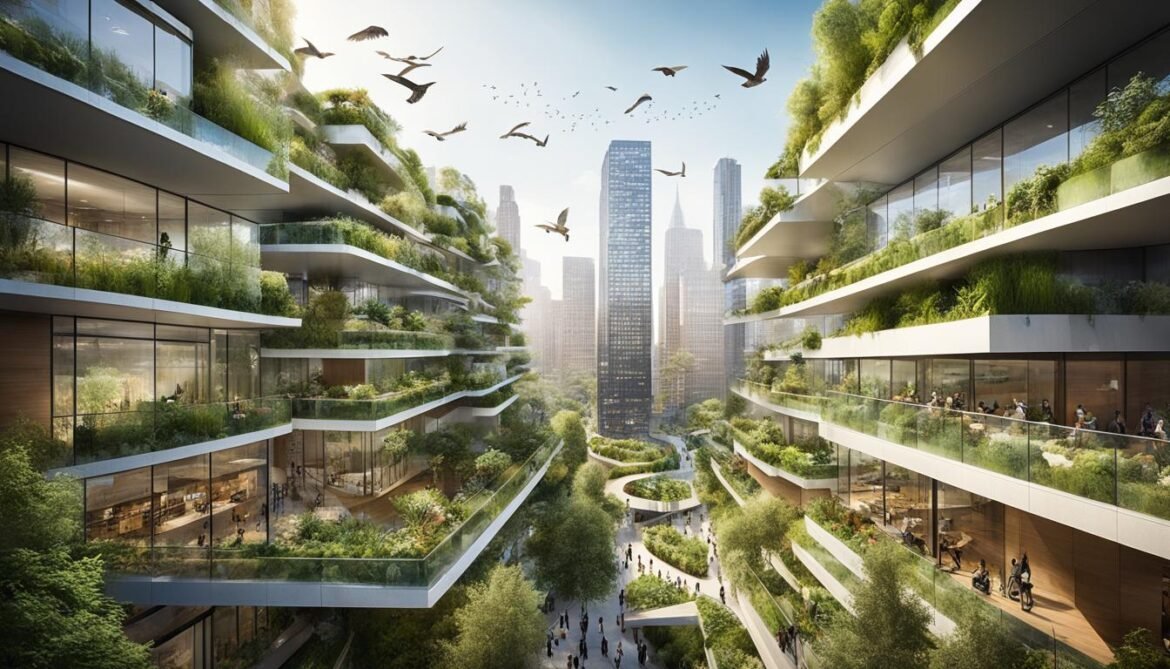
Wildlife Corridors: A Solution for Biodiversity Connectivity
Human activities like building roads and cities cut up natural habitats. This makes it hard for animals to move around. It lowers their chance of finding new partners to breed with and increases their risk of going extinct. But, creating wildlife corridors helps join these separated areas. Animals can then move between places, share genes, and adapt to new challenges.
Reconnecting Isolated Populations
Building wildlife corridors helps overcome the problems of disconnected habitats and separated animal groups. They link up diverse areas, allowing wildlife to travel safely. This way, they mix genes, avoid becoming too small in number, and stay better prepared for the future. Uniting these populations is key to their survival and ability to cope with changes.
Promoting Gene Flow and Adaptation
By creating wildlife corridors, we improve the mixing of genes among animal and plant groups. This keeps their genetic diversity strong, helping them survive different environmental pressures. It’s especially important with new threats like changing climates and cities. These corridors help species adapt and ensure ecosystems remain healthy in the long run.
Mitigating Human-Wildlife Conflicts
Wildlife corridors not only help animals but us too. By giving animals safe passages, they reduce visits to our cities and farms. This lowers the chance of dangerous encounters and encourages peaceful sharing of spaces. It benefits both us and the animals, helping us live together more safely.
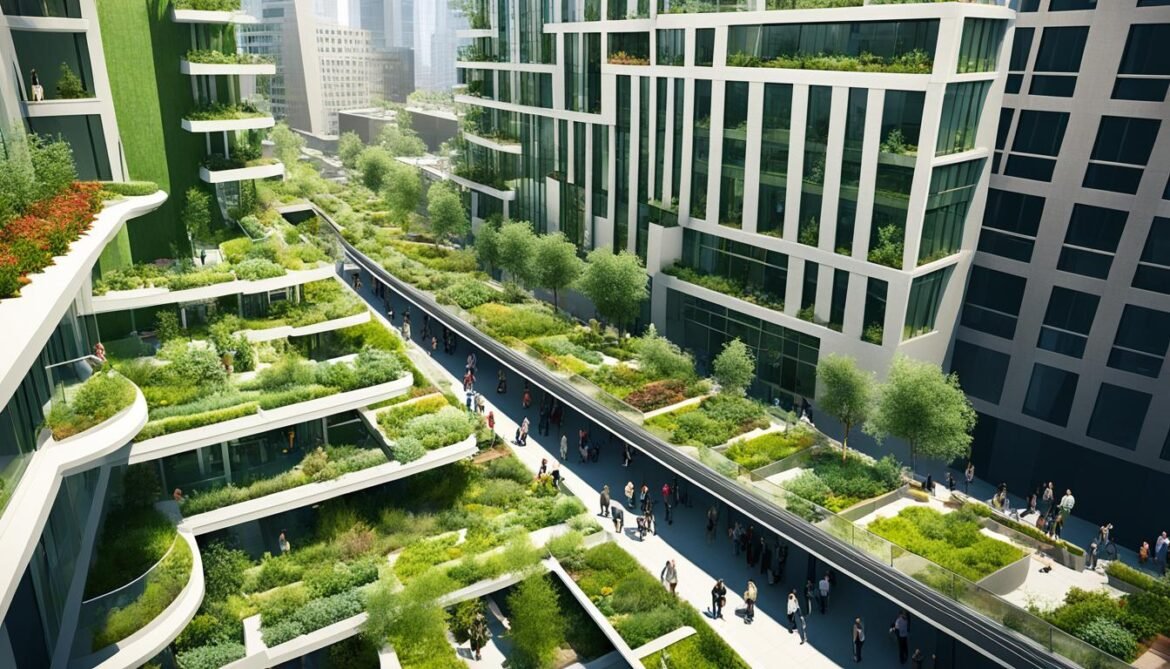
Challenges of Implementing Wildlife Corridors in Urban Areas
Wildlife corridors aim to improve connections between nature in cities. But, setting them up faces some big issues. The first problem is habitat fragmentation. As cities grow, they cut up the natural spaces that animals use to move. With these spaces gone, creating effective corridors becomes hard.
The mix of land ownership and usage in cities also makes things tough. Many different people and companies own the land. This mix can slow down the process. Getting everyone to agree and allowing the use of the land can take a lot of time.
Then, there’s the issue of disciplinary silos. This means that different groups, like architects and planners, don’t always work together. They might plan without considering nature. This leads to patchy solutions that don’t really help the wildlife.
One more hurdle is urban sprawl. As cities get bigger, they swallow up more nature. The roads and buildings they add can block the way for wildlife. This makes it hard for corridors to serve their purpose.
To beat these challenges, cities need to work in a few ways. They must bring different experts together. They should also make plans that keep nature in mind. By working together and thinking ahead, we can make our cities fit for all kinds of life.
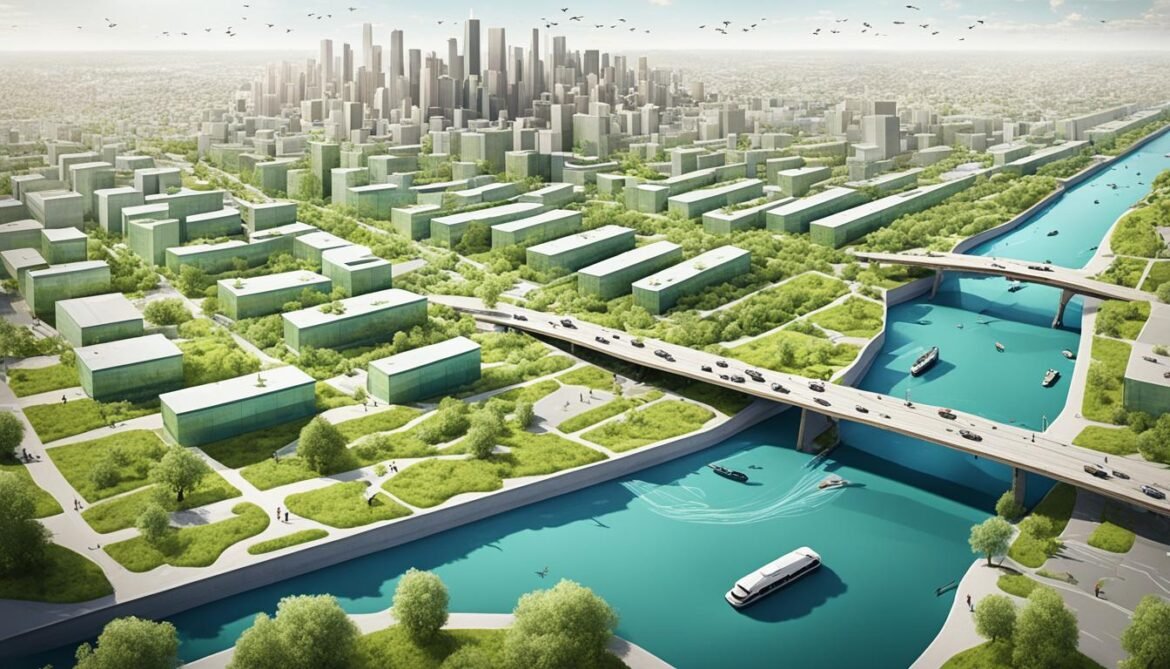
Strategies for Urban Wildlife Corridor Conservation
Keeping and improving urban wildlife corridors is key to keeping biodiversity in cities. It needs a mix of strategies. These work to make and keep habitats, help animals move around, and save important areas. In the end, they help look after city animals and encourage cities to grow in a good way.
Green Infrastructure
Green spaces like parks, greenways, and city forests are important for city animal pathways. They give homes to many creatures and help them travel. Careful planning means these green places form a big web of animal homes, helping city wildlife corridor conservation.
Backyard Habitat Restoration
Getting locals involved in fixing up their back gardens can really help urban wildlife corridor conservation. People can plant native plants, put out bird feeders, and make small safe spots for wildlife. This adds to the whole city’s green infrastructure and gives wildlife more places to thrive.
Land Acquisitions
Buying or protecting key bits of land is crucial for letting city wildlife live on. Connecting these areas means the city’s nature can stay healthy. It takes effort from landowners, nature groups, and the city to pick and protect these key bits.
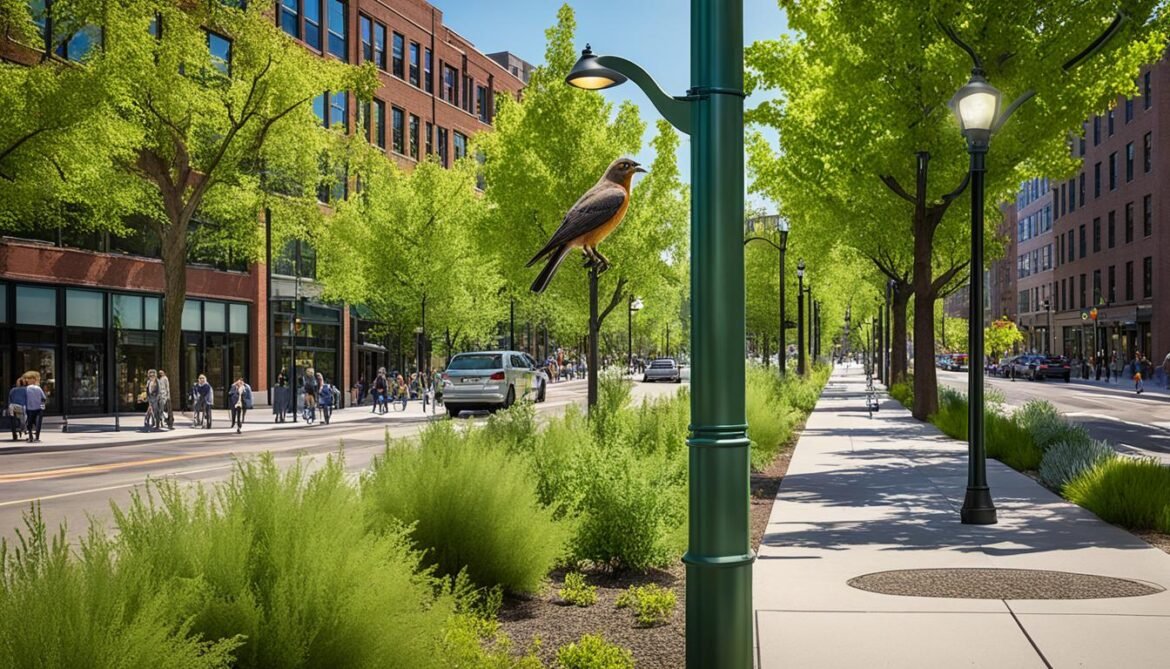
| Strategy | Description | Key Benefits |
|---|---|---|
| Green Infrastructure | Integrating parks, greenways, and urban forests to create a network of interconnected habitats. | Provides vital habitats, facilitates wildlife movement, and enhances urban biodiversity connectivity. |
| Backyard Habitat Restoration | Engaging local communities to restore and manage backyard habitats, creating a patchwork of hospitable refuges. | Supplements the urban green infrastructure and provides resources for local wildlife populations. |
| Land Acquisitions | Strategically acquiring and protecting critical habitat patches through purchases or conservation easements. | Secures vital habitats and corridors, ensuring the long-term viability of urban ecosystems and wildlife populations. |
The Role of Landscape Architecture in Biodiversity Conservation
Landscape architects have a key part in creating and looking after green areas. They make these spaces better for plants and animals, as well as for people. The American Society of Landscape Architecture (ASLA) supports a big worldwide goal. The goal says we should save and bring back 30% of the Earth’s natural areas by 2030.
The work of landscape architects is very important for this goal. They show that we can plan and design places that help nature bounce back. Their designs help plants and animals to live and move around easily.
Landscape architects use smart ways to make cities good for nature. They plant local plants and help natural workers like bees and butterflies. This turns dull city spots into lively homes for a wide range of life. They also make sure these places are linked, so animals can move around freely.
Landscape architects are experts at making sure new buildings and areas fit in well with the environment. They check the area first to save any special plants or animals. Their plans include green areas that welcome wildlife right into the city.

| Key Strategies for Landscape Architects in Biodiversity Conservation | Outcomes |
|---|---|
| Incorporating native plant species | Supports local ecosystems and provides habitat for native wildlife |
| Designing for pollinator-friendly landscapes | Enhances pollinator populations and promotes ecosystem health |
| Enabling integrated pest management | Minimises the use of harmful pesticides and promotes natural pest control |
| Protecting and restoring on-site habitats | Preserves existing biodiversity and creates new ecological niches |
| Linking habitats through ecological corridors | Facilitates the movement and migration of species, enhancing connectivity |
Landscape architects are leaders in saving nature in our urban areas. They create new and sustainable designs based on science and nature. These designs help our cities and nature live together well.
Nature-Based Solutions for Biodiversity Enhancement
Now, more than ever, the focus is on making our cities greener and sustainable. Nature-based solutions are key in this effort. They help increase the variety of plants and animals, or biodiversity. This change is especially beneficial for areas that lack natural green spaces, like cities.
Heterogeneity and Diversity in Design
Using many different types of plants and habitats in cities is important. It helps insects, birds, reptiles, and mammals find a place to live. This makes cities more diverse and resilient. It’s not just about looks; it’s about creating a living space for many species.
Mimicking Nature in Functional Diversity
Sometimes, the best designs come from nature itself. Swales, rain gardens, and green roofs copy the way nature handles water. They also provide homes for bees and butterflies. This design approach is good for both people and wildlife.
Enhancing Insect, Bird, Reptile, and Mammal Biodiversity
Nature-friendly designs can really boost city life for animals. They make spaces that birds and bats love to live in. Placing special homes for them helps create a healthier environment.
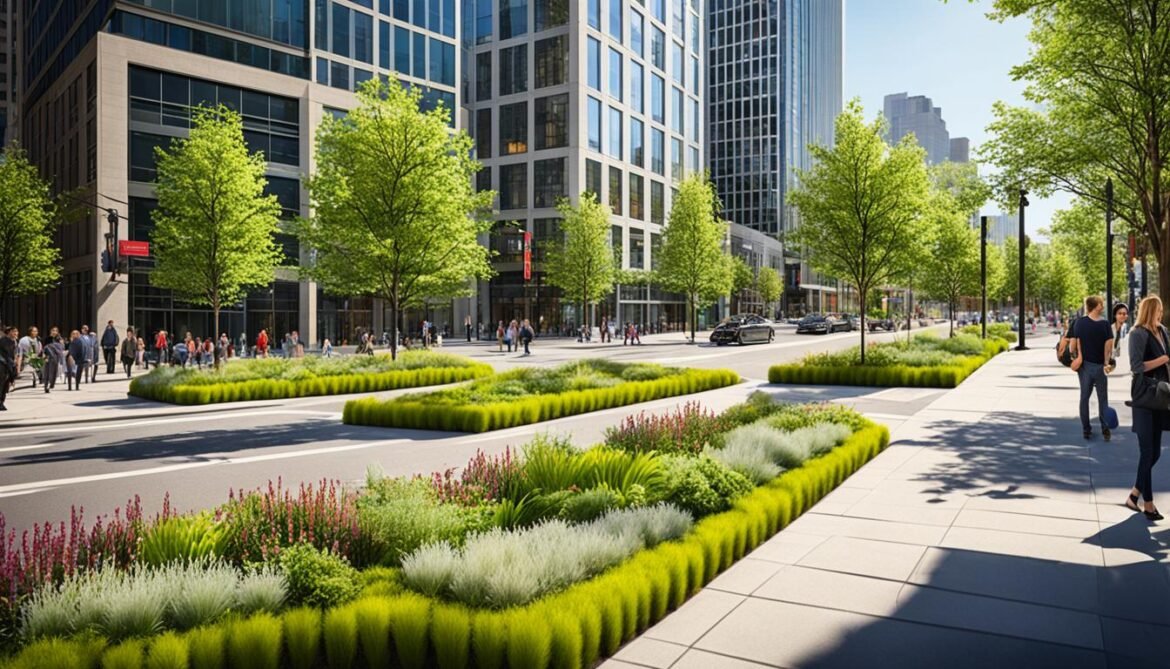
| Biodiversity Element | Design Strategies | Potential Benefits |
|---|---|---|
| Insect Biodiversity | Using local plants that bees and butterflies like, making places for insects to stay, and adding water spots. | This boosts the work of bees and helps nature recycle, keeping the ecosystem healthy. |
| Bird Biodiversity | Setting up spots with food, water, and homes for birds, and growing a variety of plants that attract them. | It increases the number of birds, controls pests, and makes the city more beautiful and lively. |
| Reptile Biodiversity | Planting things that give reptiles good places to hide and look for food. | It controls insects and small animals, making the city’s nature balanced. |
| Mammal Biodiversity | Building paths with plants, adding homes for bats, and planting trees that feed animals. | It brings in more small and medium animals, important for many natural jobs. |
Architectural Strategies for Enhancing Urban Biodiversity
Architecture helps to boost biodiversity in cities. This is done by creating spaces that offer homes to various species. Architects use design to protect natural habitats and ensure their connection with others.
Incorporating Native Plants
Using local plants in green spaces is a key approach. Native greens are not only beautiful but also vital for local animals. Architects can make areas where plants and animals live well together.
Supporting Pollinators
Animals like bees and butterflies are crucial for city life. By designing spaces that welcome these creatures, architects support urban nature. This care helps keep our city environments in balance.
Enabling Integrated Pest Management
Avoiding harmful chemicals in pest control is important. With IPM, architects can design with nature to handle pests. This method not only keeps the environment healthy but also supports a variety of life.
Incorporating Protected Areas
Setting aside natural spaces in cities is essential. Working with experts, architects help keep these areas safe. This ensures urban nature continues to thrive.
Transforming Grey to Green
Turning concrete to green spaces does wonders for city biodiversity. Green roofs and walls are examples of how. They provide homes for many and make cities cooler and cleaner.
Retrofitting Grey Infrastructure to Be Green
Even existing city structures can be made more nature-friendly. By adding green to these ‘grey’ places, architects make them better for all. This makes cities greener and more sustainable.

Building Community Coalitions for Biodiversity
To protect urban biodiversity, we must join forces. Architects and planners need to work with local groups, sharing ideas and resources. Together, their efforts can make lasting changes for the better.
Creating Community Partnerships
It’s key to form strong community partnerships for biodiversity. These groups should include everyone, from residents to authorities. This wide range of views helps address challenges and look after green areas.
Participatory Design Processes
When everyone gets a say, it makes a big difference. This means architects and planners should listen to locals and indigenous groups during each step. The results will match what the community really needs and values.
Involving Indigenous Groups and Stakeholders
Learning from indigenous groups can supercharge our efforts in saving biodiversity. Working with them, we can create plans that deeply respect local traditions and nature. It’s a win-win for everyone.
Biodiversity Metrics and Regulations
In tackling biodiversity loss, cities worldwide are taking bold steps. They are adopting strategies to measure and control urban biodiversity. For example, the Singapore Index on Cities’ Biodiversity was introduced in 2008. It is a powerful tool for assessing biodiversity conservation efforts and planning specific actions.
The Singapore Index contains 23 indicators. It evaluates different parts of urban biodiversity, like the variety of native species and the usage of natural spaces. Cities use these measures to see how well they are doing. They can then pinpoint areas that need work and set plans to boost biodiversity in their areas.
A recent global move to boost biodiversity is the BiodiverCities by 2030 initiative. It started in 2021 with support from the World Economic Forum and the IUCN. This initiative seeks to make nature a core part of city planning and development. The target is to have 30% of urban spaces dedicated to nature by 2030.
The UK has also set up a regulation called Biodiversity Net Gain. Put into action in 2021, it mandates that new projects must increase their biodiversity value. This measure pushes developers to focus on preserving and improving natural areas. It ensures that as cities grow, nature doesn’t suffer.
These methods show that cities are becoming key players in protecting and renewing our natural world. By applying biodiversity-friendly strategies in development, cities are heading towards a more sustainable future. A future where our urban areas and nature can thrive together.
Architectural Approaches to Fostering Biodiversity
Cities are becoming more important in the battle to save our planet’s wildlife. Architecture plays a big part in this. It helps by adding new homes for animals in urban areas, keeping current habitats safe, and connecting these areas together.
Creating Habitat Opportunities
Designers, like architects and planners, can make spaces that welcome many creatures. They do this by adding things like green roofs, walls that live, and using plants that are natural to the region. This type of design can give insects, birds, and small animals a place to thrive.
Protecting On-Site Habitats
It’s also key to save plant and animal homes already there. Protecting big trees, streams, and other natural spots is vital. Such efforts make sure new developments fit well into the local environment.
Minimizing Construction Impact
When building, we must be careful not to harm the wildlife living nearby. Taking small, careful steps in building sites, like saving parts of the land for nature, can do a lot. This includes doing construction in phases and using materials that don’t disturb animals.
Conclusion
Cities are growing fast, making it vital to think of new architectural strategies that connect with biodiversity. These include wildlife corridors, green spaces, and animal-friendly buildings. This work by architects and urban planners is essential for healthy and diverse urban environments.
The key is working together across different areas. This means teaming up with ecologists, planners, architects, and the community. By joining forces and making nature part of city planning, we can aim for a future where cities and the natural world live in balance.
Tackling habitat loss, saving species, and creating green cities is a major challenge. The field of architecture is critical in finding new ways to protect our urban biodiversity for years to come.




